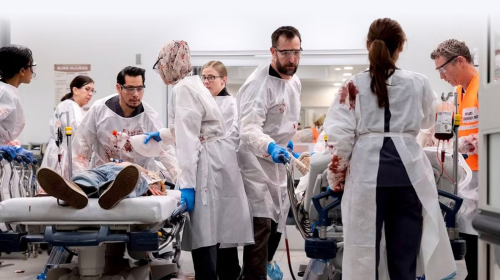From how to train to what to eat, here are science-backed ways to overcome Ozempic-triggered muscle loss

The current weight loss conversation would be impossible without acknowledging the presence of GLP-1 medications. You’ll likely best know them by their brand names – including Ozempic, Wegovy and Mounjaro – and it’s estimated that one in eight adults in the US, equivalent to 15 million people, have given the semaglutide-based drugs a go. However, as more of the global population enlist them on their health journeys, the lesser-known side effects are coming to light – with inadvertent muscle loss now the prime focus of wellness-conscious users.
According to Harvard Health, GLP-1 medications work by slowing down stomach emptying, which keeps you feeling fuller for longer, and they also send corresponding signals to the brain. It’s the shrunken appetite levels of users that leads to reduced food intake and consequently, varying levels of weight loss. Data from clinical trials shows that, on average, patients are losing 15% of their body weight. Further still, aside from helping those who are overweight or obese slim down, there have been a number of other reported physiological benefits. One recent study found the drugs – which are usually administered as a weekly injection – could improve kidney function, while there’s evidence of improvements to cardiovascular health.
However, if you are exploring these GLP-1 medications for healthy weight management, then it is important to consider what happens to your body composition when you lose weight rapidly – or even when you do so more slowly. Indeed, there have been growing reports of ‘microdosing’ as part of a trend for ‘biohacking’, which has been popularised by those wanting to swerve symptoms like nausea as well as constipation while also keeping cost down. There is evidence that a dose of 0.05 milligrams per day is both safe and effective – even though the standard starting dose of Ozempic has been 0.25 milligrams.
One of the reasons why ‘microdosing’ has risen in popularity is due to a belief that it may help mitigate muscle loss. Indeed, as for regular doses of the medications, research has revealed the risk for a decrease in muscle mass alongside fat loss, with a review of ten studies finding that approximately 28% of weight loss comes from the former. Experts say this is down to a reduced calorie intake causing the body to break down muscle, as well as fat, to use for fuel. This is a worry since having adequate muscle is important for everything from strength and moving as you want, to protecting your joints as well as bones and maintaining your metabolism.
So, whether you have been prescribed a GLP-1 medication or are considering taking the drug, there are some key ways you can simultaneously protect your all-important muscle. That includes, even if your appetite might be low, consuming enough protein in your diet – ideally from whole food sources like fish, yoghurt and beans – to help maintain muscle. There’s evidence that 0.5g to 3.5g of protein per kg of body weight is necessary to support increases in lean body mass. Within this, you want to ensure that you get your fill of the amino acid leucine – that’s particularly crucial in growing and repairing muscle tissue, and can be found in eggs and chicken. There is likewise evidence that supplementing with creatine can bolster muscle mass, while dehydration – which is reportedly more of a risk on these medications – can also hamper muscle growth, so make sure you sip plenty of water.
While it is commonly thought that you need to consume protein immediately after a gym session, the latest research is that daily intake is all that matters – regardless of whether that’s post-workout or not. Talking of which, there’s evidence that exercise of any kind can also play a huge role in preserving and increasing muscle. However, research has shown that doing strength training – which can include using your bodyweight, lifting weights and enlisting resistance bands – can particularly minimise muscle loss. The CDC recommends doing at least two resistance sessions a week, alongside at least 150 minutes of moderate-intensity physical activity – which can be split into 30 minutes, five days a week.
That being said, if you are unsure about your nutrition or fitness routine, it’s important to consult a relevant expert – like a dietitian or personal trainer – for personalised advice. Further still, it;’s vital to understand that these medications should only be taken under the supervision of a doctor, and you should speak to a healthcare professional if you are worried at all about muscle loss and how to approach it. Indeed, while discussions surrounding weight loss medications often focus on aesthetics and body confidence, it is crucial to remember that it’s what’s going on inside your body that really counts when it comes to the ultimate health goal of longevity.












